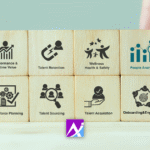With many companies transitioning to remote work in an effort to maintain social distancing during the COVID-19 (coronavirus) outbreak, it may be a challenge for your leaders and employees to get used to teleworking. As you transition your workforce to remote work environments, following these guidelines on how to work remotely will help set your organization up for success without impacting employee health.
Communicate clearly and regularly
Your employees are probably seeing a lot of coverage in the media and may feel overwhelmed by the communications they’re receiving internally and externally. Share the reason why your organization is transitioning to remote work and continue to reinforce why the decision was made. Sharing the rationale behind the decision with your employees will help them appreciate why the decision was made, especially if they would rather be in the office.
Check-in with members of your team regularly and establish regular digital communications. Schedule virtual meetings together to communicate, if network bandwidth allows for it, you can use video conferencing as a way to increase the feeling of connectedness.
Don’t be afraid to over-communicate. Letting your employees know what is going on within the organization can help calm and provide a sense of security within the business. Don’t hold communications because there are unknowns, there will always be unknowns in situations that are constantly evolving. Be transparent about what you don’t know and what you are doing to help find answers. Let your employees know where to go with questions or concerns.
Set Expectations Internally and Externally
Setting clear expectations and continuing to manage expectations will help your team navigate new situations. After you establish expectations solicit feedback from team members and allow time for conversation around any concerns or feelings that your team may have. It is important that your employees feel like their voice has been heard and that their opinion is valued. Expectations around working remotely should cover any core work hours of operations where employees are expected to be online, what tools and resources your team should be used remotely, preferred methods of communication and regular check-ins.
A transition to a predominately remote work environment may also impact your stakeholders, which could be internal or external. Think about all of your stakeholders which internally could include human resources, finance, marketing and externally could include clients and vendors. If you believe your remote work arrangement could impact your normal course of business identify those potential gaps and brainstorm around ways to close them. Let all stakeholders know about the transition to remote work and what they need to know about doing business with your organization during this time.
People Optimization Platform
Tailored Solutions
Helpful Resources
Our Company
Unlock your organization’s full potential with the industry’s premier pre-employment and people optimization platform.
- Contact Our Sales Team | (313) 914-5885
- Contact Customer Support | (313) 914-5885
Experience the power of the AcuMax Index firsthand with a FREE assessment and personalized analysis today!
- © AcuMax Index, 2025. All Rights Reserved.





